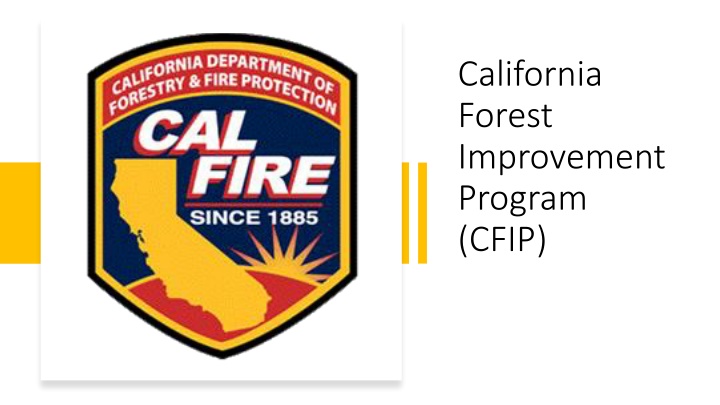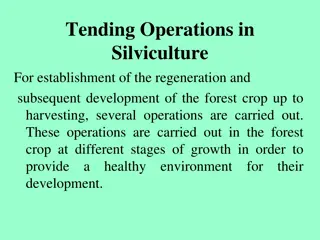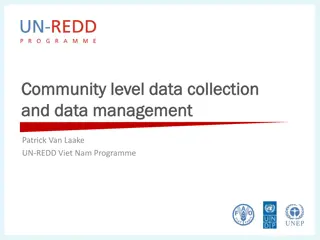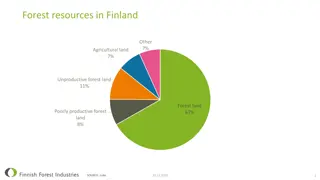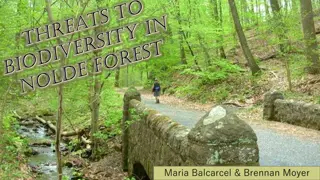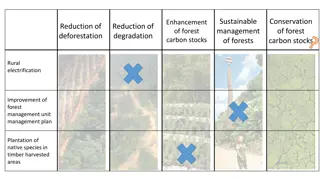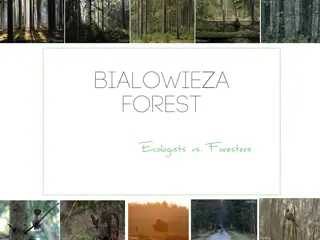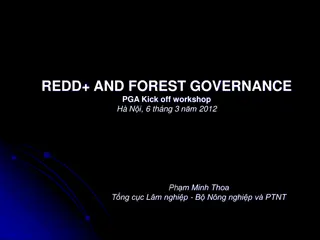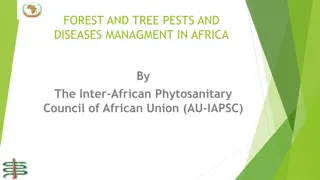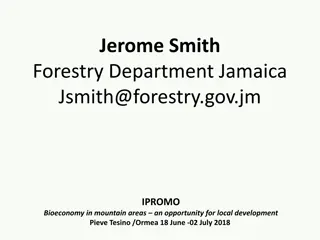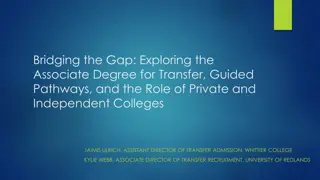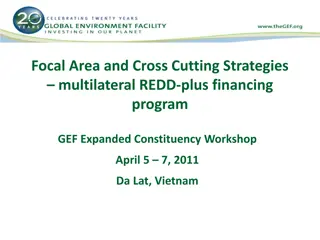California Forest Improvement Program (CFIP) Overview
The California Forest Improvement Program (CFIP) aims to promote investments in forestlands to ensure timber supplies, employment, and economic benefits while enhancing the forest resource. Funding sources, program objectives, eligibility requirements, and reimbursement details are covered in the presentation. CFIP offers technical and financial assistance for forest management investments, with a focus on reforestation and resource improvement practices.
Download Presentation

Please find below an Image/Link to download the presentation.
The content on the website is provided AS IS for your information and personal use only. It may not be sold, licensed, or shared on other websites without obtaining consent from the author.If you encounter any issues during the download, it is possible that the publisher has removed the file from their server.
You are allowed to download the files provided on this website for personal or commercial use, subject to the condition that they are used lawfully. All files are the property of their respective owners.
The content on the website is provided AS IS for your information and personal use only. It may not be sold, licensed, or shared on other websites without obtaining consent from the author.
E N D
Presentation Transcript
California Forest Improvement Program (CFIP)
Topics Covered in this Presentation I. Program Overview II. Eligibility Requirements III. How to Get Started
I. Program I. Program Overview Overview
The purpose of the California Forest Improvement Program (CFIP) is to encourage private and public investments in forestlands and resources within the state to ensure adequate future high quality timber supplies, related employment and other economic benefits, and to protect, maintain, and enhance the forest resource for the benefit of present and future generations. Purpose of the Program
The source of funds for CFIP projects historically came from California s Forest Resource Improvement Fund (FRIF). FRIF receives its funding from timber sale revenue from the State s Demonstration Forests. CFIP no longer receives money from the FRIF fund How the Program is Funded Funding may be provided from other State sources; e.g. the Greenhouse Gas Reduction Fund, General Fund and the Timber Regulation and Forest Restoration Fund. Currently, CFIP has funding and is funding projects It is important to note that different funding sources may have different requirements or additional application procedures. Be sure to discuss this with your Forestry Assistance Specialist (FAS) for the county in which your project resides. A list of contacts is provided on the CFIP webpage.
Under current State law, CFIP can provide eligible landowners with technical and financial assistance for planning, reforestation and resource management investments that improve the quality and value of forestland and woodlands. What the Program Does CFIP is a reimbursement program, i.e. a cost-share program. To receive reimbursement from CFIP, you must first provide documents to the FAS to demonstrate that the expenses to be reimbursed have been paid out. CFIP typically provides reimbursement for up to 75% or 90% of the state cap cost of a project, with the maximum reimbursement amount capped at a rate set in the approved CFIP agreement package. Cost share percentage reimbursement dependent on acreage of ownership
Preparation of a Forest Management Plan by a Registered Professional Forester (RPF). Practices Eligible for CFIP Cost- Sharing RPF Supervision of the following: Reforestation Site Preparation Trees and Planting Tree Shelters Stand Improvement Pre-commercial Thinning or Release Pruning Follow-up (includes mechanical, herbicide and/or slash disposal follow-up) Forestland conservation practices / fish and wildlife habitat improvement
II. Eligibility II. Eligibility Requirements Requirements
To be eligible for CFIP, landowners must own at least 20 acres of forestland but not more than 5,000 acres of forestland in California. Eligible Landowners The 20-acre minimum does not apply to forestland zoned timber production zone. As per PRC 4793(e), forestland means land at least 10 percent occupied by trees of any size that are native to California, including native oaks, or formerly having had that tree cover and not currently zoned for uses incompatible with forest resource management.
Eligible landowners include: Private persons Government agencies LLCs, Trusts, Corporations Non-federally owned Native American lands CFIP contracts with the deeded landowner. Lease holders are not eligible. Eligible Landowners continued
The intent of the California Forest Improvement Act of 1978 is to ensure that investments in timber stand improvement funded by CFIP will yield future marketable forest products and/or improved natural resources. Land must be zoned for uses compatible with forest resource management. Land in Agricultural Preserve (Williamson Act) or Timberland Production Zone (TPZ) qualifies. Properties with conservation easements or zoned for residential and/or commercial development may be eligible, if the easements or zoning place no restriction on forest management practices. Eligible Forestland If land is not zoned for timber production, the owner must maintain funded practices for at least ten years. A notice to this effect will be filed with the County Recorder. If the land is sold this provision is binding on the new owner or the CFIP grant must be paid back with interest.
CFIP requires that a Forest Management Plan be prepared and approved prior to a forest resource improvement project being started. An existing non-industrial timber management plan (NTMP), CFIP management plan, or NRCS management plan may be adequate. If a new or revised management plan is required, then the program can provide cost share funding for its completion by a private RPF. New provisions have been added to allow for emergency notices under the Forest Practice Act to be used as a management plan in areas substantially damaged by fire, insect, etc. The emergency notice must fist be salvage logged and have a completion report signed off by the local CAL FIRE Unit Requirement for a Forest Management Plan
Minimum Acreage of Eligible Projects Timber related practices including site preparation, planting, precommercial thinning, release, and follow up work shall cover at least a contiguous 5-acre project area. Any combination of practices may be used in the contiguous 5-acre project area as appropriate to meet the landowner s objectives. There is no minimum acreage limit for land conservation or habitat improvement projects.
Commercial timber operations require the approval of a timber harvest plan, non-industrial timber management plan, emergency notice or exemption by CAL FIRE under the Z berg-Nejedly Forest Practice Act of 1973 (Forest Practice Act). NO Commercial Timber Operations A CFIP application for only a Forest Management Plan may overlap commercial operations. A proposed CFIP project with ground practices overlapping commercial operations shall not be approved until after either: A final completion and stocking report has been approved An exemption or emergency has expired and been inspected by the FAS to verify that operations are completed. Proposed CFIP projects adjacent to approved commercial harvesting operations shall include close coordination with the local Forest Practice Inspector, and may be approved.
III. How to III. How to Get Started Get Started
Overview of the Application Process Step 1: Contact a FAS Step 2: Initial application Step 3: Field inspection Step 4: Final application filed and ranked Step 5: Application approved or denied funding
Preconsult with your local FAS to determine the status of funding, current application process, and whether your property and project are eligible for funding. Step 1: Contact a FAS To find your FAS: 1. Go to the CAL FIRE CFIP webpage at https://www.fire.ca.gov/grants/california-forest- improvement-program-cfip/ or search CAL FIRE CFIP in your search engine. 2. On the right side of the webpage, click on Contact A CFIP Forest Advisor, then scroll through the list to the county the property is located in.
Contract the services of a consulting California Registered Professional Forester (RPF) to assist in writing the elements of the application package, including the CFIP application, agreement forms, Payee Data Record form, project budget, project description, RPF checklist, copy of the Property Deed or Certificate of Trust, and maps. Additional documentation may be needed to demonstrate property ownership. Step 2: Initial application
Step 3: Field inspection The FAS will schedule a field inspection with you and your RPF to review your proposed project in the field for eligibility, proposed treatments, and accuracy of the prepared documents.
Step 4: Final application filed and ranked If the FAS determines that your project meets the requirements of the program, the FAS will provide recommendations for completion of the final application package. All application revisions must be completed before the project is filed. The final application package will be filed and ranked per the CFIP ranking form.
Each project will be assigned a priority rank. This priority ranking will be used for approving and funding projects on a bi-monthly basis where only the highest-ranking projects will be funded until the program funding allocation is reached. Applications that are not funded in their first opportunity will be forwarded for consideration in the proceeding funding window. If an application is not funded in its second attempt, the application may be returned to the landowner for revision. Step 5: Application approved or denied
For More Information Go to https://www.fire.ca.gov/grants/california- forest-improvement-program-cfip/ Read the CFIP User s Guide, posted on the right side Subscribe for program e-mail updates, subscribe button at bottom of page Contact your FAS cfip@fire.ca.gov
